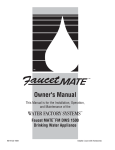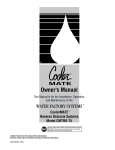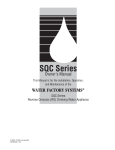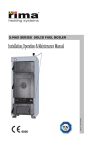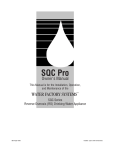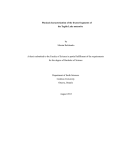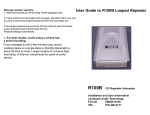Download Water Factory Systems FaucetMATE Owner`s manual
Transcript
® Owner's Manual This Manual is for the Installation, Operation, and Maintenance of the ® WATER FACTORY SYSTEMS FaucetMATE Drinking Water Appliance © 2002 CUNO Incorporated 98-91121 0902 INTRODUCTION This manual explains the installation, operation and maintenance of the Water Factory Systems’ FaucetMATE® Drinking Water Appliance. Please read each section of this manual carefully. The specific model chosen should be appropriate for the local water conditions and the customer’s needs. Check the Performance Data Sheet for the performance characteristics and the conditions of use. The Water Factory Systems’ drinking water appliances are designed to connect permanently to a home plumbing system. To ensure that the installation conforms to your state and local plumbing codes, it is recommended that the installation be performed by a qualified installation specialist for drinking water appliances or a licensed plumber. Failure to install the system as instructed will VOID the warranty. TABLE OF CONTENTS I. Installation Instructions A. B. C. D. E. F. G. H. I. J. K. Installation precautions....................................................................................................3 Determine system location ..............................................................................................3 Prepare the area for installation ......................................................................................3 Prepare the system for installation ..................................................................................3 Locating the faucet ..........................................................................................................3 Make the faucet mounting hole........................................................................................4 Mounting the faucet ........................................................................................................4 Mounting the drinking water filtration system ................................................................4 Installing the feed water valve..........................................................................................5 Make the tubing connections ..........................................................................................5 Installing and replacing filter cartridges ..........................................................................5 II. Illustrations 1. 2. 3. 4. System location ..............................................................................................................6 Faucet installation ............................................................................................................6 Feed water valve installation ............................................................................................7 How to use “Push In connectors ....................................................................................7 Congratulations and thank you for purchasing the Water Factory Systems’ FaucetMATE® Drinking Water System. You are about to enjoy the benefits of high quality drinking water right in your own home. The FaucetMATE dual-stage filtration systems contain the most effective filtration media for reducing common but potentially harmful pollutants. The FaucetMATE line consists of the FM-2 CTO for reduction of chlorine, taste and odors, the FM-2 Lead for the reduction of lead, chlorine, taste and odors, and the FM350-DWS for the reduction of volatile organic chemicals (VOCs), MTBE, lead, chlorine, taste and odors, sediment and mirco organisms such as cysts. All FaucetMATE systems operate on regular household water pressure. This manual explains the installation, operation and maintenance of your FaucetMATE Drinking Water System. Please read each section of this manual carefully. The system is designed to connect permanently to a home plumbing system. To assure that the installation conforms to your state and local plumbing codes, it is recommended that the installation be performed by a qualified installation specialist for drinking water appliances or by a licensed plumber. A. Installation Precautions The exact placement of the various components of the system will vary from installation to installation. The installer, in conjunction with the customer, must decide on where to place the faucet and filtration system by balancing the home owner’s convenience with ease of installation and servicing (see Figure 1). • The tubing must be installed in the correct inlet and outlet fittings as labeled. Make sure not to reverse the connections. • Do not install on a hot water line. The maximum temperature allowed is 100°F (38°C). C. Prepare the area for installation • Do not install on a line with water pressure above 125 psi (862 kPa). Remove supplies from under the sink and stack them neatly away from the working area if necessary. Inspect the cold water supply line and determine if any special fittings, in addition to what is included in the kit, are required. • Do not use a torch or other high temperature sources near the filtration assembly or the plastic cartridges. NOTE: It is a good idea at this time to check the condition of the undercounter plumbing for any existing or potential leaks. Any items of concern should be repaired prior to installation of the drinking water device. • Special care must be taken when drilling the holes for the mounting bracket. Use caution when installing near electrical wires or water pipes. • Protect from freezing. Drain the filtration system when the room temperature drops to 32°F (0°C) or below. D. Prepare the system for installation Open the shipping carton and remove the components. Check to see that all of the installation parts are present. They should include the filtration system, faucet, installation hardware and tubing. • Do not install in direct sunlight. • Allow a minimum of 2” (5 cm) clear space under each filter cartridge to facilitate cartridge change. E. Locating the faucet • Mount the filtration system in a location that will minimize the chance of it being struck by other items, such as waste baskets, etc. Select a sink or countertop location at least 2” (5 cm) in diameter on which to mount the drinking water faucet. The faucet should be positioned so that it empties into the sink. Make certain the location directly underneath this area is free of obstruction in order to accommodate the faucet assembly. If the sink already has a hole provided that can accommodate the faucet, then no drilling is required and you can proceed to the section on mounting the faucet (see Figure 1). • The installation must comply with existing state and local plumbing codes. • Do not use where water is microbiologically unsafe, or with water of unknown quality without adequate disinfection before or after the system. B. Determine System Location The filtration system should be located under the sink. Never install it in an area of the home where the temperature may drop to freezing, because damage to the system will result. 3 F. Make the faucet mounting hole Procedure: 1) Mark the center for the 9/16" hole. 2) Form a shallow putty dam around the hole area and fill it with enough water to lubricate the carbide drill bit. 3) Carefully drill a pilot hole through the porcelain/enamel and the base metal using a carbide type pilot drill. Important: Always operate the drill with light pressure at a slow speed (300-400 rpm). 4) Insert the pilot tip of the spring-loaded porcelain cutter into the pilot hole. 5) Drill the porcelain/enamel using the spring-loaded porcelain cutter, making certain a complete ring has been cut through the porcelain/enamel to the metal base. 6) Change to the metal cutter. With a slow speed and light pressure, cut away the inner porcelain/enamel disc down to the base metal. Make certain that the cutter does not touch the outer rim of the cut porcelain/enamel. Continue with this bit to cut through the metal until the sink has been completely penetrated. IMPORTANT: It is mandatory that safety glasses by worn during the sink hole drilling operations in order to prevent eye injury. IMPORTANT: Extreme care must be taken when drilling the hole for the faucet. The surface material is hard and brittle and easily chipped or cracked. The manufacturer assumes no responsibility for sink damage resulting from this installation. A wide variety of faucet mounting situations may be encountered, the most common being stainless steel and ceramic-onmetal sinks. Consult a plumber for the other materials that may be encountered. Before drilling the hole, always check underneath the sink to ensure that nothing will interfere with mounting the faucet such as reinforcing ribs, support brackets or the cabinet construction. Stainless steel sink. Recommended tools: • Center punch • Variable speed drill and high speed drill bits • Chassis punch 9/16" size • Protective gloves G. Mounting the faucet 1) Remove all of the hardware from the threaded nipple of the faucet except for the rubber washers and the chrome base plate (See Figure 2). The rubber washer may be replaced with a small amount of putty for a nicer appearance. 2) Put the threaded nipple through the faucet mounting hole and position the faucet spout over the sink. 3) From below the sink/countertop, assemble the plastic bottom washer, star washer and hex nut onto the threaded nipple and tighten it by hand (see Figure 2). 4) After rechecking the faucet orientation, tighten the hex nut with a 9/16” wrench until the faucet feels secure. 5) From above the sink, make any minor orientation corrections by turning the faucet on its “flats” with a padded adjustable wrench. Use care so as not to mar the chrome finish. Procedure: 1) Center punch a small indent at the center of the desired faucet location. 2) Slowly drill the required pilot hole for the chassis punch. 3) Set up the chassis punch per the instructions and tighten the nut to cut the desired hole size. 4) Clean up all sharp edges with a file if necessary. Porcelain/Enamel/Ceramic sink on sheet metal or cast iron base. Recommended tools: • Variable speed drill • Porcelain cutter tool set 9/16" size • Plumber's putty H. Mounting the drinking water filtration system NOTE: Be sure to locate the system where there is a minimum of 2” (5 cm) clearance underneath it to facilitate filter cartridge changes. It is important to understand what is involved in this procedure. First, the glassy layer of porcelain must be penetrated through to the base metal. Second, a center disc of porcelain must be removed while protecting the surrounding porcelain against chipping or fracturing. Third, the base metal must be drilled through to complete the hole. 1) Mark the mounting screw locations on the cabinet sidewall using the holes on the bracket as guides. 2) Drill starter holes into the sidewall. 3) Hang the filtration system onto the sidewall by fastening wood screws through the bracket and into the mounting surface. IMPORTANT: When using a porcelain cutter it is critical that it is always in a sharpened condition. Dull cutters are known to chip sinks. 4 I. Installing the feed water valve J. Make tubing connections The saddle tapping valve which is supplied is designed to be used on 3/8” - 1/2” OD soft copper tubing (plain or chromed) and rigid metal pipe. Do not use with flexible ribbed tubing because it requires special hardware. Optional feed valves should be used for this purpose. NOTE: With all of the components in place, the tubing connections can be made. Be sure to arrange the tubing so that there are no sharp bends. Leave some “play” in the tubing for ease of servicing. NOTE: Try to keep the tubing from the filtration system to the faucet as short as possible to ensure good water flow. IMPORTANT: Some local plumbing codes may prohibit the use of saddle-type valves. In this case, optional feed valve assemblies should be used. 1) Connect the 1/4” orange tubing to the “Push In” male connector on the inlet side of the filtration assembly (refer to Figure 4 on the use of “Push In” plastic fittings). Soft Copper Tubing Installation: A) Turn off the cold water feed valve under the sink, or the main feed valve for the house. B) Before installing the saddle tapping valve, make sure the piercing lance does not protrude beyond the rubber gasket. See instructions on bag. C) Place saddle tapping valve around the copper tubing and tighten the mounting screw until the valve is tight. Be careful not to deform the copper tubing (see Figure 3). D) To pierce the soft copper tubing, turn the handle clockwise until it is firmly seated. The valve is closed in this position. E) Turn on the main supply valve to pressurize cold water line. Check for leaks. F) Connect a length of 1/4” orange tubing to the feedwater valve, using the insert, plastic sleeves and brass compression nut. 2) Connect the 1/4” blue tubing from the faucet to the “Push In” fitting attached to the outlet connection on the filtration assembly. K. Installing and replacing filter cartridges NOTE: In order to ensure proper performance, it is essential that the filters be installed in the correct location. Use the icon coded labels to match the filter cartridges with their corresponding filter head. 1) Close the feed water valve and lift up the faucet handle. Wait approximately 10 seconds for the system to depressurize. 2) Twist the filter cartridge 1/4 turn to the left so that the ears on the cartridge are able to disengage from the head. Firmly pull the cartridge downward to remove it from the head. It may be necessary to twist the cartridge slightly from side to side to help free it from the head. 3) Remove the new filter cartridge from its sanitary sealed wrapper. (Double check to see that it is the correct replacement filter cartridge by comparing the labels.) 4) Using either tap water, food grade silicone lubricant or glycerine, lubricate the o-ring seals to make cartridge insertion easier. 5) Line up the cartridge ears, insert the cartridge and push it up into the head until it is firmly seated. Twist the cartridge 1/4 turn to the right to lock it into place. 6) Open the feed water valve and carefully check for leaks. 7) Allow system to operate with the faucet open for at least 10 minutes. This will allow the cartridge to properly flush prior to use. Rigid Metal Pipe Installation: A) Turn off the cold water feed valve under the sink, or the main feed valve for the house. B) Drill a 3/16” hole at the desired location on the metal pipe. To prevent shock hazard, use a battery operated drill. C) Turn the saddle tapping valve clockwise to expose the piercing lance beyond the rubber gasket no more than 3/16”. D) Place saddle tapping valve around the copper tubing making sure the piercing lance is located in the hole and tighten the mounting screw until the valve is tight (see Figure 3). E) Turn saddle valve handle clockwise to close valve. F) Turn on the main supply valve to pressurize cold water line. Check for leaks. G) Connect a length of 1/4” orange tubing to the feedwater valve, using the insert, plastic sleeve and brass compression nut. 5 Figure 1 Faucet Feedwater Valve FM-2 & FM-2 Lead Plus Figure 2 Rubber Washer Chrome Base Plate Rubber Washer Plastic Bottom Washer Star Washer Hex Nut 6 Figure 3 Valve Handle Stem Nut/Seal Piercing Lance Insert Plastic Sleeve Compression Nut 1/4" Orange Feedwater Tubing For 3/8" OD tubing, use the side of the bracket with the projections. For 7/16" to 1/2" OD tubing or rigid pipe, use the "V" side of the bracket. Figure 4 ‘Push-In’ Tubing Connector This product is outfitted with user friendly ‘Push In’ connectors. Proper use of the connectors is shown in the diagrams. It is most important that the tubing selected for use with these connectors be of high quality, exact size and roundness, and with no surface nicks or scratches. If it is necessary to cut the tubing, use a plastic tubing cutter or sharp razor knife. Make a clean square cut. Should a leak occur at a ‘Push-In’ connector, the cause is usually defective tubing. To Fix: To Attach Tubing 1 Tube O-Ring • Relieve pressure • Release tubing • Cut off at least 1/4” from end. • Reattach tubing • Confirm connection is leak free. To Release Tubing 1 2 Push in grey collet to release tubing. Pull tubing straight out. 2 Grey Collet Push tubing straight in as far as it will go. Tubing is secured in. 7 Figure 5 To Faucet Outlet Fitting with Flow Control Feedwater Inlet 47-55711G2 47-55707G2 47-55707G2 From Feedwater Source FM-350 DWS NOTE: Some state and local plumbing codes may prohibit the use of saddle-type valves and/or drain connections. The use of saddle-type valves are prohibited in: Alaska, Delaware, Idaho, Kentucky, Massachusetts, Michigan, Minnesota, New Hampshire, North Dakota, Ohio, Oregon, and South Dakota. Check your local plumbing codes for any restrictions that may apply. Massachusetts CMR 248 strictly prohibits the use of saddle-type valves. The feedwater connection must conform to applicable plumbing codes. 8 CUNO Incorporated 400 Research Parkway Meriden, CT 06450, U.S.A. Toll Free: 1-800-733-1199 Worldwide: 203-237-5541 Fax: 203-238-8701 www.waterfactorysystems.com • www.cuno.com









